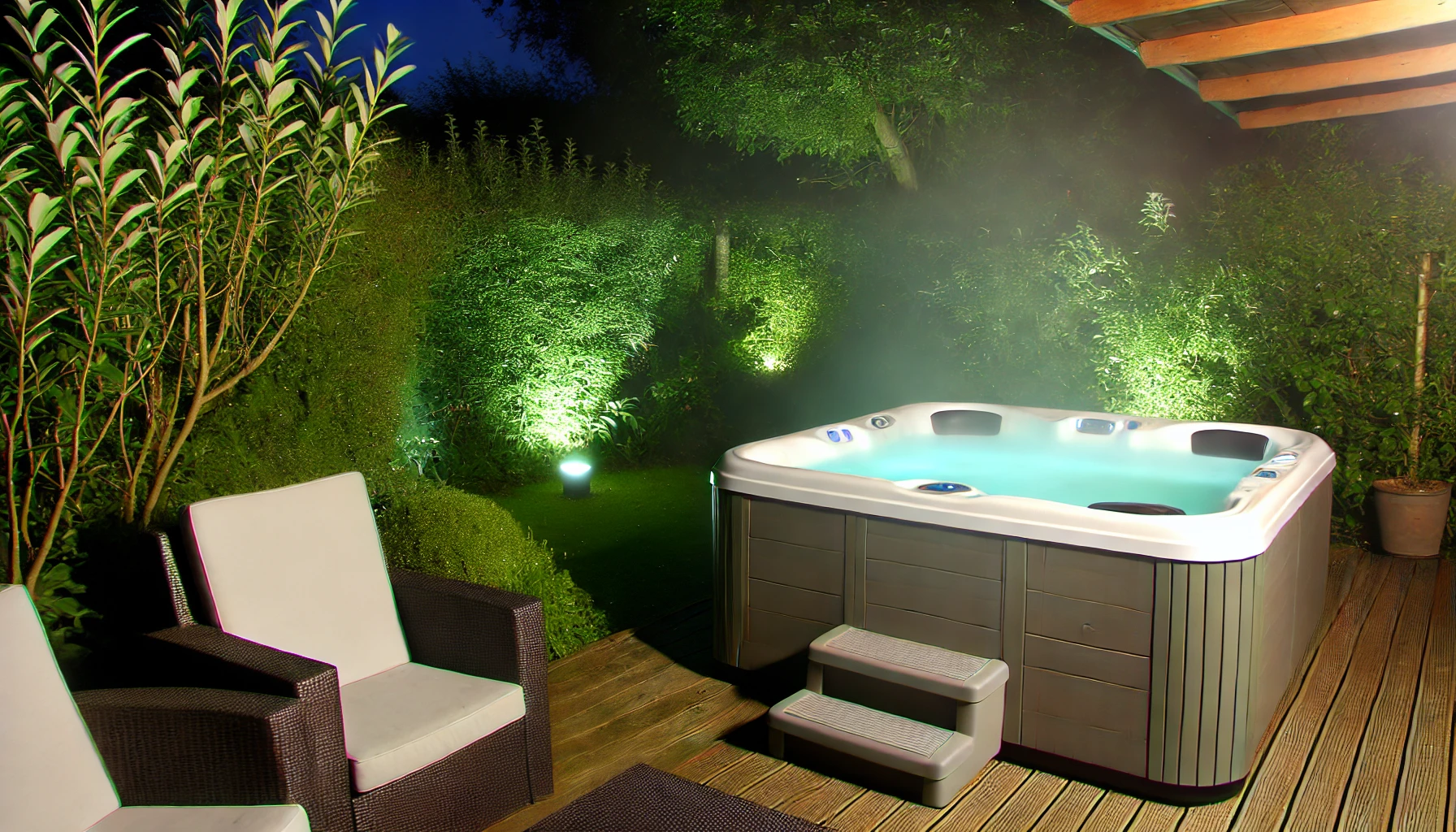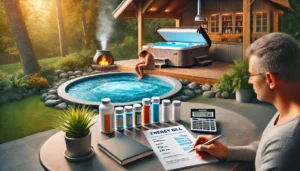Ah, the joys of owning a hot tub! There’s nothing quite like sinking into warm, bubbling water after a long day.
The gentle jets massaging away your stress, the steam rising into the cool night air – it’s pure bliss. But wait, what’s that? Foam?!
Ugh, talk about a mood killer. I’ve been there, folks, and let me tell you, it’s not fun.
But don’t worry, I’ve got your back. Let’s dive deep into the foamy world of hot tub troubles and learn how to keep your spa experience smooth sailing… er, soaking.
What Causes Foam in a Hot Tub
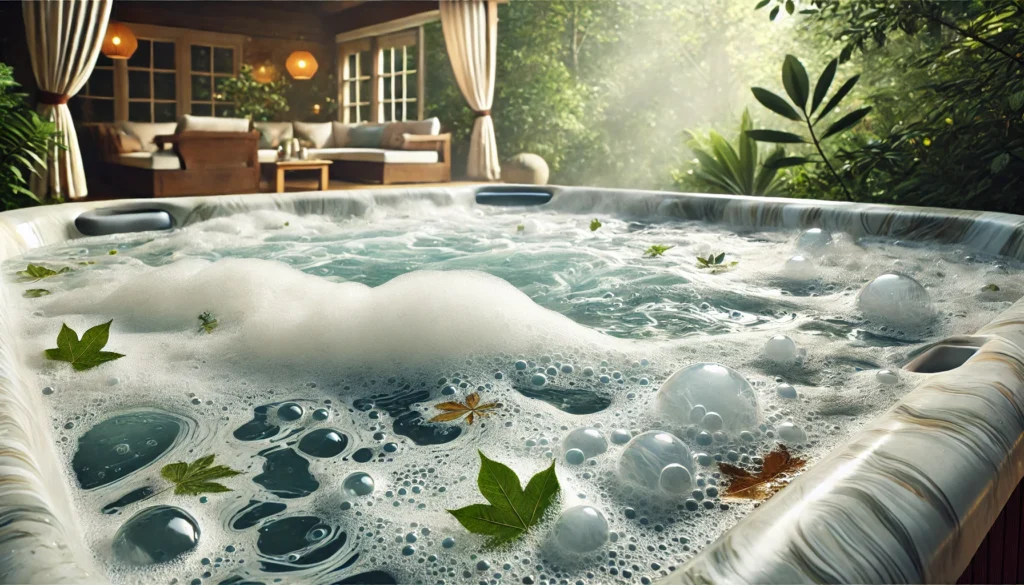
Hot tub foam is primarily caused by a buildup of organic compounds and chemical imbalances in the water.
Body oils, lotions, detergents from swimwear, and cosmetic residues introduce substances that reduce water surface tension.
This allows bubbles to form and persist longer than usual. Chemical imbalances, particularly high pH or low calcium hardness, create an environment conducive to foam formation.
Organic matter contamination from leaves, insects, and pollen, as well as biofilm buildup in the plumbing, also contribute to foaming.
These factors combine to create the perfect conditions for stubborn foam in your hot tub.
How to Get Rid of Hot Tub Foam
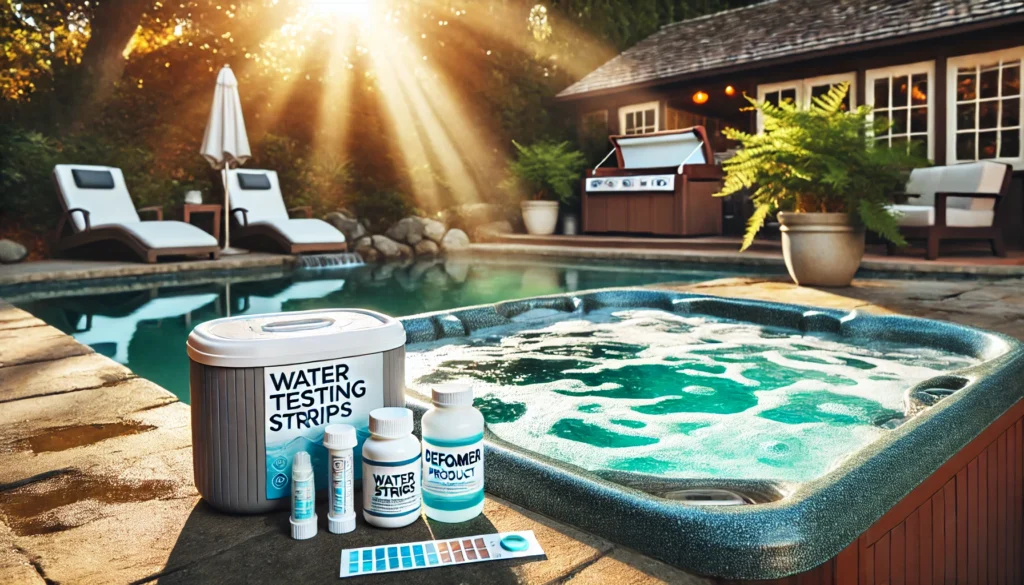
To eliminate hot tub foam, you need to address both the immediate issue and its underlying causes. Start by shocking the water to oxidize contaminants and restore balance.
Use a defoamer product sparingly for quick relief, but don’t rely on it long-term. Clean or replace your filter to ensure proper filtration.
If the problem persists, drain and refill the hot tub. Address biofilm by using a line flush product in the plumbing.
Regularly test and adjust water chemistry, maintaining proper pH, alkalinity, and sanitizer levels.
Prevent future foam by showering before use, avoiding fabric softeners on swimwear, and educating guests about proper hot tub etiquette.
Consistent maintenance and vigilance are key to keeping your hot tub foam-free and enjoyable.
The Science Behind Hot Tub Foam
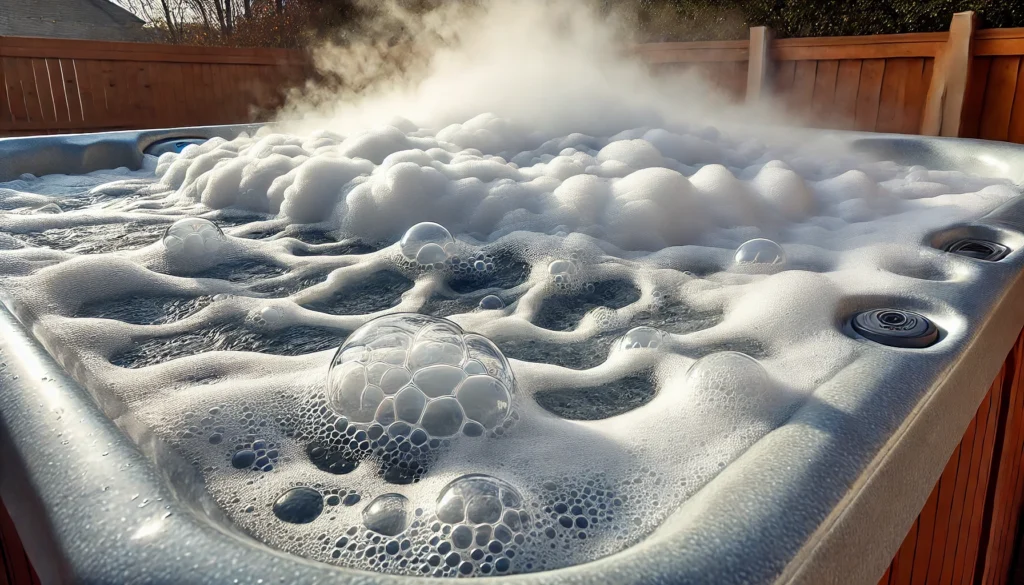
Let’s get a bit nerdy for a moment, shall we? Understanding the science behind hot tub foam can help you tackle the problem more effectively.
At its core, foam is just a collection of bubbles. But why do these bubbles form and stick around in your hot tub?
It all comes down to surface tension. Water molecules are naturally attracted to each other, creating a kind of “skin” on the surface of the water.
This surface tension is what allows some insects to walk on water – pretty cool, right? But when you introduce certain substances into the water, they can reduce this surface tension.
Think of it like this: imagine you’re at a crowded party, and everyone’s standing close together. That’s your water molecules with high surface tension.
Now, imagine someone comes in and starts pushing people apart. That’s what contaminants do to your water – they get between the molecules, reducing the surface tension and making it easier for bubbles to form and stick around.
The jets in your hot tub create bubbles naturally, but with normal surface tension, these bubbles would quickly pop and disappear.
When the surface tension is lowered, however, the bubbles stick around, accumulating on the surface and creating that pesky foam.
Common Causes of Hot Tub Foam

Now that we understand the science, let’s talk about the usual suspects behind this frothy fiasco. I’ll never forget the time I threw a hot tub party and ended up with a foam disaster.
It was like a bubble bath gone wild! After some detective work (and a lot of googling), I discovered several culprits.
First up, we’ve got body oils and cosmetics. Our bodies naturally produce oils, and many of us use lotions, deodorants, and other products that leave residues on our skin.
When we hop into the hot tub, these oils and residues wash off and mix with the water. Yep, that fancy lotion you slathered on before taking a dip? It’s a foam factory waiting to happen.
Then there’s the issue of detergents from swimwear. Ever tossed your swimsuit in with your regular laundry? Big mistake!
Residual detergent can cause major foam issues. I learned this the hard way when my favorite trunks turned my hot tub into a bubble bath.
Even if you rinse your swimsuit after washing, trace amounts of detergent can remain and contribute to foam formation. Chemical imbalance in water is another culprit, and it’s a bit trickier.
If your pH, alkalinity, or sanitizer levels are off, it can create the perfect environment for foam to flourish. It’s like creating a foam party, but not the fun kind.
High pH levels, in particular, can increase the likelihood of foam formation. Additionally, low calcium hardness can contribute to foaming, as it affects the water’s ability to hold onto dissolved solids.
Organic matter contamination is yet another foam-causing culprit. Leaves, bugs, pollen, and other debris can break down in your hot tub, creating a foamy mess.
I once found a frog in my skimmer basket – poor little guy was like a protein shake for foam production! These organic materials release compounds as they decompose, which can lower water surface tension and contribute to foaming.
Last but not least, let’s talk about biofilm. This slimy layer of bacteria can build up in your pipes and equipment, continuously releasing substances that promote foam formation.
It’s like having a hidden foam factory in your hot tub’s plumbing!
How to Identify the Source of Hot Tub Foam
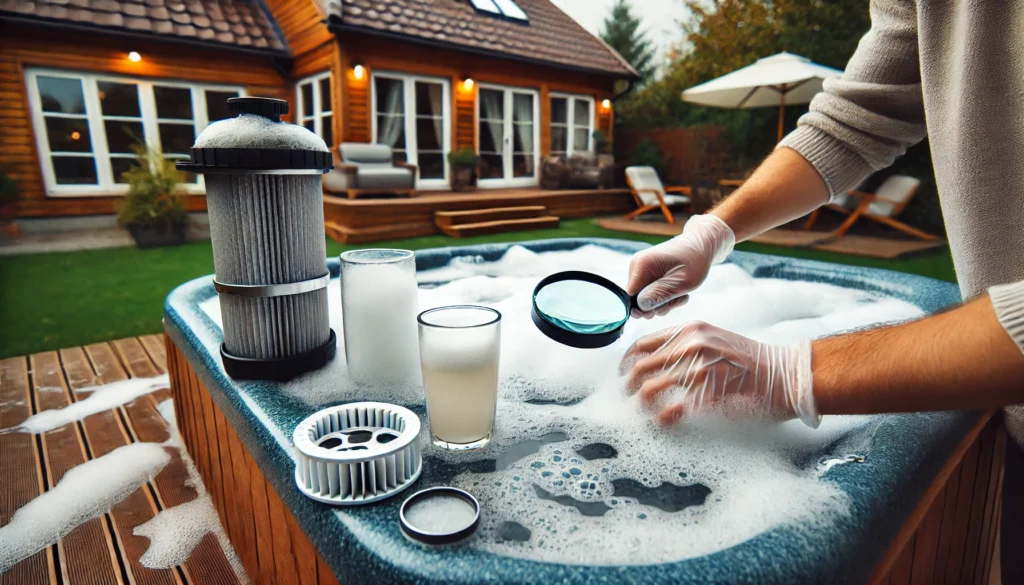
Alright, time to put on your detective hat. Here’s how to crack the case of the mysterious foam.
Start with a visual inspection. Take a good look at your water.
Is it cloudy? Are there any visible contaminants? I once saw what looked like an oil slick on the surface – turned out my friend had used way too much sunscreen before jumping in.
Look for any unusual colors or odors too. A strong, musty smell could indicate the presence of bacteria or algae, which can contribute to foaming.
Water testing is crucial, folks! Get yourself a good testing kit and check those chemical levels.
I can’t tell you how many times I’ve thought I had the perfect balance, only to find out I was way off. Pay special attention to pH, alkalinity, and sanitizer levels.
Also, check your total dissolved solids (TDS) – high TDS levels can contribute to foaming. Don’t forget to consider recent use and maintenance.
Think back – did you have a big party recently? Skip a cleaning? Forget to shower before your last soak?
Sometimes the answer is right there in your recent history. Keep a log of hot tub use and maintenance – it can be incredibly helpful in identifying patterns or issues.
Inspect your filter too. A dirty or clogged filter can’t effectively remove contaminants, leading to a buildup of foam-causing substances.
If you can’t remember the last time you cleaned or replaced your filter, that might be your culprit right there. Finally, check your hot tub cover.
A worn or damaged cover can allow debris and contaminants to enter your hot tub, contributing to foam formation.
Plus, if your cover isn’t properly ventilated, it can create a breeding ground for bacteria, which can exacerbate foaming issues.
Effective Methods to Eliminate Hot Tub Foam.
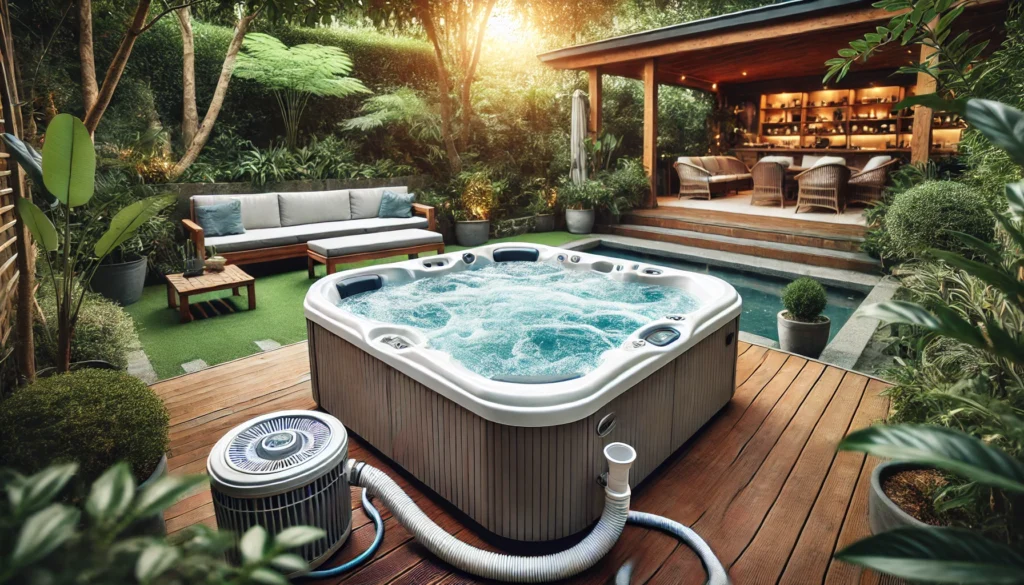
Now for the fun part – getting rid of that pesky foam! Here are some tried-and-true methods to combat the froth.
Shock treatment is like hitting the reset button on your hot tub. It oxidizes contaminants and helps restore balance.
Just be careful not to overdo it – I once used too much shock and turned my hot tub into a chlorine soup. Not pleasant!
When shocking your hot tub, always follow the manufacturer’s instructions and ensure proper ventilation. After shocking, run the jets for at least 30 minutes to circulate the treated water thoroughly.
Using a defoamer product can work wonders. These are like magic potions for foam.
They break down the surface tension that allows bubbles to form. But use them sparingly – they’re not a long-term solution.
Defoamers are great for quick fixes, but they don’t address the underlying causes of foam. Plus, overuse can lead to other water balance issues.
Sometimes you just gotta start fresh by draining and refilling the hot tub. It’s a pain in the butt, but it’s the most effective way to get rid of built-up contaminants.
Plus, there’s something satisfying about filling up a squeaky clean tub. When refilling, use a hose filter to remove impurities from your source water.
This can help prevent future foam issues. Don’t forget about proper filtration and circulation.
Make sure your filter is clean and your jets are running regularly. Good circulation is like a gym workout for your hot tub – it keeps everything healthy and balanced.
Clean your filter at least monthly, and consider a deep clean or replacement every few months, depending on usage. Addressing biofilm is crucial for long-term foam prevention.
Use a line flush product before draining your hot tub to clean out those pipes and eliminate the hidden foam factory. This should be done at least once a year, or more frequently if you use your hot tub often.
Balancing your water chemistry is key. Test and adjust your pH, alkalinity, and sanitizer levels regularly.
Aim for a pH between 7.2 and 7.8, alkalinity between 80 and 120 ppm, and chlorine levels between 1 and 3 ppm (or bromine between 2 and 6 ppm). Don’t forget about calcium hardness too – keep it between 150 and 250 ppm to prevent both scaling and foaming.
Preventing Hot Tub Foam in the Future

An ounce of prevention is worth a pound of cure, right? Here’s how to keep the foam at bay and enjoy crystal-clear waters all year round.
Regular maintenance routines are key. Set a schedule and stick to it!
Clean your filter, check your chemicals, and give your tub some TLC on the regular. I like to do a quick check every other day and a more thorough maintenance session weekly.
Trust me, your future self will thank you for staying on top of things. Always shower before use.
I know, I know, it seems counterintuitive to shower before getting in water. But trust me, your hot tub will thank you for not bringing in extra oils, cosmetics, and other contaminants.
Make it a house rule – no one gets in the hot tub without a quick rinse first. Maintaining proper chemical balance is crucial.
Keep those levels in check! It’s like a chemistry experiment, but way more fun (and with better results).
Invest in a good testing kit and learn how to use it properly. Digital testers can be more accurate and easier to read than strip tests.
Consider avoiding certain products. Say goodbye to fabric softeners on your swimwear, and maybe rethink that super-oily sunscreen.
Your foam-free hot tub will be worth the sacrifice! Opt for hot tub-friendly sunscreens and lotions if you must use them.
Educate your guests about hot tub etiquette. It might feel a bit awkward, but a quick rundown of dos and don’ts can save you a lot of hassle later.
Make it fun – maybe create a cute sign with hot tub rules, or turn it into a game. Invest in a good cover and use it religiously.
A quality cover not only keeps debris out but also helps maintain water temperature and chemical balance. Clean your cover regularly and replace it when it shows signs of wear and tear.
Consider using enzyme products regularly. These break down organic contaminants and can help prevent foam formation.
They’re like little pac-men, munching away at the stuff that causes foam. Finally, don’t neglect your hot tub’s plumbing.
Regular line flushes and the occasional use of biofilm eliminators can keep your pipes clean and foam-free.
When to Call in the Pros
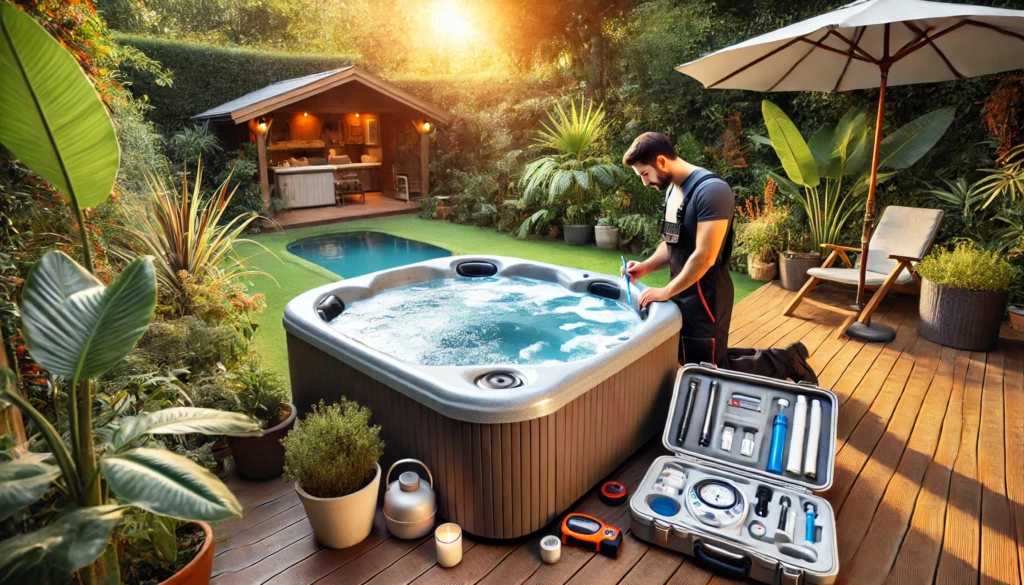
Sometimes, despite our best efforts, hot tub problems can persist. If you’ve tried everything and still can’t get rid of that stubborn foam, it might be time to call in a professional.
Here are some signs that it’s time to seek expert help:
Persistent foam that doesn’t respond to treatment
Unusual odors or colors in your hot tub water
Difficulty maintaining proper chemical balance
Suspicious noises or performance issues with your hot tub equipment
A professional can perform a thorough inspection, identify any hidden issues, and provide specialized treatments.
They might even catch potential problems before they become major headaches.
Consider it an investment in your hot tub’s longevity and your peace of mind.
The Environmental Impact of Hot Tub Maintenance
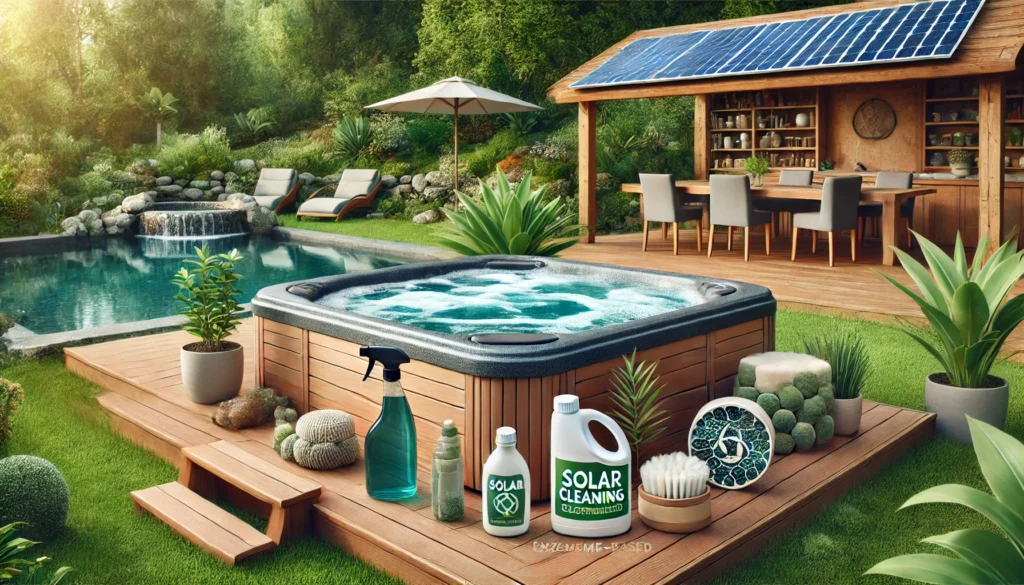
As hot tub owners, it’s important to consider the environmental impact of our maintenance practices. Many traditional hot tub chemicals can be harsh on the environment when drained.
Consider using eco-friendly alternatives when possible, and always dispose of hot tub water properly according to local regulations. Some eco-friendly practices include:
Using enzyme-based cleaners instead of harsh chemicals
Opting for natural sanitizers like mineral purifiers
Properly disposing of old filters and other hot tub waste
Using a solar cover to reduce energy consumption
Remember, a well-maintained hot tub is not only more enjoyable but also more energy-efficient and environmentally friendly.
Conclusion
Well, folks, we’ve come to the end of our foamy journey. We’ve explored the causes of hot tub foam, delved into the science behind it, and armed ourselves with an arsenal of tools and techniques to combat it.
Remember, a little foam is normal, but if your hot tub looks like a bubble bath, it’s time to take action. Keep up with regular maintenance, be mindful of what you bring into the water, and don’t be afraid to call in the professionals if things get out of hand.
Hot tub care might seem like a chore, but trust me, it’s worth it for those perfect, relaxing soaks. Hot tub ownership is a journey, not a destination.
There will be ups and downs, foamy times and crystal-clear times. But with the knowledge you’ve gained today, you’re well-equipped to handle whatever your hot tub throws at you.
And hey, if you’ve got any wild hot tub foam stories or tips of your own, share ’em in the comments! Let’s keep the conversation flowing – just not as foamy as our hot tubs.
Here’s to many more relaxing, foam-free soaks in your future!
